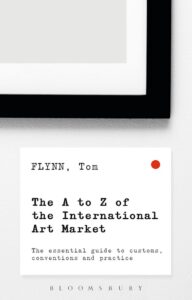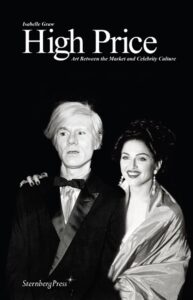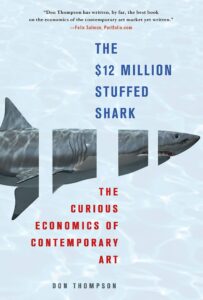Why to Collect Art? 5 Books To Delve Into The Importance Of Collecting.
Amassing artwork is far more than a pastime. It is a exercise that can have economic, social, historical and even political implications. How to identify the value of collecting one particular or one more piece? What does it suggest to collect art professionally? What elements must I consider into account?
The adhering to listing of guides addresses, from a important and reflective point of check out, the distinctive aspects that one will have to know when staying a qualified collector.
1. The A-Z of The Worldwide Art Marketplace by Tom Flynn
It is approximated that there are in excess of 300,000 businesses associated in the world’s artwork market, employing all over 2.8 million men and women. But the art world carries a veneer of mystery and secrecy that a lot of persons come across complicated, and the language applied by current market insiders can be alienating and confusing to individuals new to the art market place.
The A-Z of the International Art Sector not only clarifies useful terms and definitions, but also signifies a considerable contribution to the speedy-producing procedures of transparency and democratisation in the worldwide artwork business enterprise. Comprising artwork sector conditions and main ideas – equally historic and contemporary – this e-book is a extensive-awaited reference supply that features a one of a kind introduction to a dynamic small business sector. Consequently, the e book delivers an accessible and extensive perception into critical areas of market place practice and custom made that everyone concerned in the art industry will find useful and enlightening.

2. Higher Selling price: Art In between The Market place and Celeb Society by Isabelle Graw
Nowadays, the artwork planet is not dominated by a small team of insiders. In accordance to Graw, the art overall economy has been reworked from a retail enterprise into an industry that creates visuality and indicating. This ebook inquiries the assumption of a dichotomy amongst artwork and the marketplace, as very well as the idea that industry worth is equivalent to artistic value. When analyzing the intrinsic connection amongst artistic manufacturing and its current market ailments, Graw also insists that art is a commodity in contrast to any other. Substantial Price statements that art and the industry have to escape each other precisely because they are so deeply entangled.
This e book presents a lot of examples to support the 1st claim of a substantial growth in the defining position of the sector and its gamers in the course of the artwork boom, who also increasingly have a say in developing creative value. There is without a doubt a great deal to suggest that in new yrs, no matter whether or not an artwork was viewed as applicable in inventive phrases depended to a bigger extent on its sector worth. But this marketplace value nevertheless depends on a “symbolic value” for its greatest legitimacy. With no symbolic benefit, no industry value—this is the book’s next claim. For if it is accurate that culture has been modifying considering that the 1970s from industrial capitalism into what Antonio Negri has known as “cognitive capitalism,” then less than such problems, enhanced value would after far more be accorded to the symbolic meaning of an artwork. The artwork earth is by definition a know-how culture, even if the spell of commercial achievement has long held sway more than it.

3. I Bought Andy Warhol (To Quickly) by Richard Polsky
In early 2005, Richard Polsky decided to put his considerably-loved, challenging-gained Warhol Fright Wig, up for auction at Christie’s. The market place for modern day art was sturdy and he was hoping to change a gain. His intuition seemed to be on focus on: his picture sold for $375,000. But if only Polsky experienced waited . . . Over the upcoming two yrs, prices soared to unimaginable heights with multimillion-greenback deals that became the norm and not the exception. Potential buyers and sellers had been baffled, artwork sellers have been bypassed for auction residences, and benchmark costs proved that trees really do mature to the sky. Experienced the industry shed all rationale?
In I Bought Andy Warhol (Too Before long), Polsky potential customers the way by way of this explosive, shorter-lived period when the “art world” grew to become the “art marketplace.” He delves into the powering-the-scenes politics of auctions, the shift in electric power absent from galleries, and the look for for cost-effective art in a rich man’s taking part in field. As opposed to most in the artwork planet, Polsky is not frightened to convey to it like it is as he negotiates bargains for shoppers in New York, London, and San Francisco and seeks out a replacement for his missing Fright Wig in a industry that has galloped past his means. A powerful backdoor tell-all about the odd and fickle world of art accumulating, I Marketed Andy Warhol (Much too Shortly) usually takes an unvarnished search at how the field shifted from artwork appreciation to monetary appreciation.

4. The $12 Million Stuffed Shark: The Curious Economics of Modern Artwork by Don Thompson
Why would a intelligent New York financial investment banker pay $12 million for the decaying, stuffed carcass of a shark? By what alchemy does Jackson Pollock’s drip portray No. 5, 1948 promote for $140 million?
Intriguing and entertaining, The $12 Million Stuffed Shark is a Freakonomics method to the economics and psychology of the contemporary art entire world. Why had been document prices reached at auction for is effective by 131 present-day artists in 2006 by yourself, with astonishing new heights reached in 2007? Don Thompson explores the funds, lust, and self-aggrandizement of the art world in an endeavor to decide what will make a specific do the job useful while other folks are ignored.
This ebook is the initially to appear at the economics and the marketing and advertising tactics that empower the modern day artwork market to deliver these astronomical selling prices. Drawing on interviews with previous and current executives of auction houses and art dealerships, artists, and the potential buyers who transfer the sector, Thompson launches the reader on a journey of discovery by means of the peculiar entire world of modern-day art. Surprising, passionate, gossipy, revelatory, The $12 Million Stuffed Shark reveals a fantastic deal that even skilled auction purchasers do not know.

5. The Change. Artwork and The Increase of Electricity of Present-day Collectors by Marta Gnyp
The Shift will take the reader on a journey via the world of modern art. Whilst analysing the motives and conduct of internationally working collectors, it explains the present acceptance of up to date artwork and discloses the unwritten principles, lively networks, and persistent myths of the speedily growing territory of artwork gathering. Collectors interact with artists, galleries, museums, and auction properties in numerous ingenious means whilst pursuing their passions and ambitions. The guide examines the attraction of gathering at large, its multifaceted social everyday living, and the monetary prospects it seems to supply.

